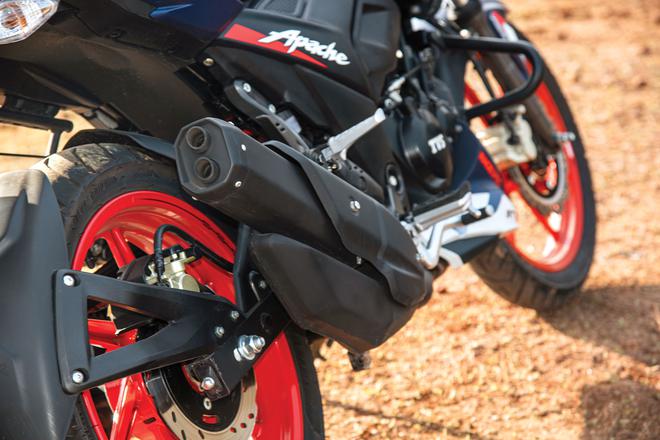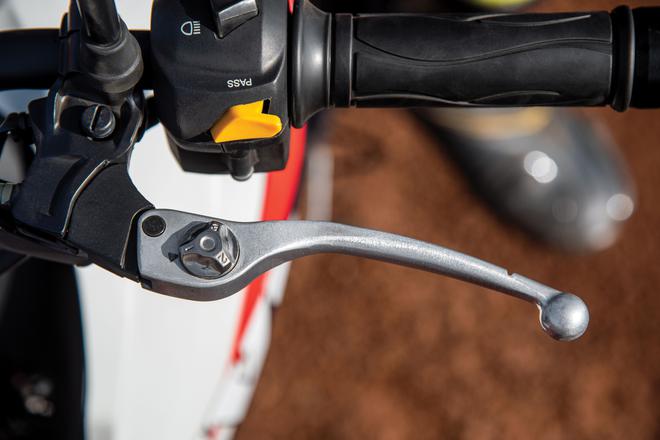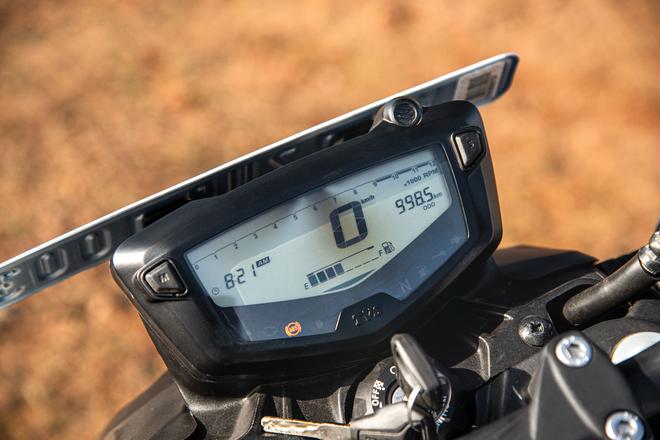TVS has a rich history in motor racing and one of the categories it has been most successful in is the 165cc Pro Stock class at the Indian National Motorcycle Racing Championship (INMRC). To comply with the rules of this class, the team has to use an appropriate engine from one of its road bikes — the 160cc unit from its Apache RTR 160 4V.
The engine is heavily modified for the race, but one thing that cannot be tweaked too much is the cubic capacity. This leaves an extra 5cc displacement that TVS could use, but is unable to, because it does not have a 165cc road bike. TVS has rectified that with the Apache RTR 165 RP. The company has built 200 of these to allow it to homologate the engine for use in next year’s national championship. It costs ₹ 1.45 lakh, which is over ₹ 20,000 more than the RTR 160 4V, which is considered to be the costliest. A break down of the pros and cons:
This bike’s displacement is a neat 164.9cc with a significant change to the cylinder head, with larger valves and ports, and different cam profiles. The piston is also different from the 160. The end result is a power figure of 19.2hp, which is higher than the 160’s 17.5hp. Torque, though, is actually slightly lower, at 14.2Nm, compared to the 160’s 14.73Nm.

This translates into a far racier motor, with more to be gained by holding gears and revving the engine out. Despite this, TVS has retained much of the tractable nature customers would expect in a bike from this segment, and it does a good job of carrying you around at lower RPMs in the city. The real joy, however is in surfing the surge of power that arrives around 6,000rpm and carries you until a little past 9,000rpm. It makes for an enjoyable (and quick) ride.
The RTR 160’s engine is known for its legendary refinement levels, and this 165cc motor is quite smooth in its own right, remaining largely vibration-free through most of the rev range.
Once you cross 7,000rpm, however, you do have a slight buzz that creeps into the bars and foot pegs. Nevertheless, for all its extra performance, the engine still throws up some pretty respectable fuel efficiency figures — 47.4kpl in the city and 56.3kpl on the highway.

Despite this bike’s sportier intent, the RP has not sacrificed in the area of comfort. You still get excellent ride quality from the well-tuned Showa suspension — most smaller bumps are quite easily gobbled up, and even over larger undulations, the RP never loses composure. The riding position is also unchanged, meaning that it is fairly upright and relaxed, but also a little cramped for your legs, with a relatively small seat-to-foot peg distance, making you want to stretch your legs every now and then.
The handling story is similar to the RTR 160 4V as well, as in, it is a rather nimble and agile motorcycle and feels sharp when slicing through fast moving traffic. When you start pushing hard in the twisties, however, in typical Apache fashion, it does feel edgy and reactive at high lean angles. Hence, it will take a pair of experienced hands to get the most out of this chassis.
Also, like the standard 160 4V, braking feel has room for improvement. Even though this bike managed to stop reasonably quickly during our ride, it did require a handful of front brake. A little more bite and feel at the lever would have been welcome on a bike that otherwise feels quite sharp.
The RP is easy to ride on a regular basis, with no real adjustment required on your part. It is marginally heavier (2kg) than the bike it is based on.
While it may share its design with the 160 4V, the RP gets a unique colour and graphics scheme, and a rather loud one at that. The red, white and blue combination is one that is hard to go wrong with, and it is executed quite well on this bike, with a neat matte finish. Great to look at, but tricky to keep clean. What would have sealed the deal, is if TVS had given these 200 bikes a special numbered plaque to really drive home the uniqueness and exclusivity.

The features department is probably this bike’s biggest shortcoming, because, despite its premium price, the RP misses out on the 160 4V’s Bluetooth connectivity, riding modes, a gear position indicator and glide-through technology. Another reminder of its racing connect is the fact that there is no side-stand engine cut-off or even indicator. What it does get is fully digital instrumentation, neat adjustable levers, a slipper clutch and an excellent LED headlight.
With this bike completely sold out for the moment, there is little point in telling you about how its pros weigh up against its cons, or whether it is worth its asking price.
What this bike is, is a display of TVS’ commitment to continue to dominate the INMRC — we cannot recall any Indian bike maker manufacturing a homologation special to aid its racing operation. But TVS has built a reputation for doing things a little differently, and it almost always works out excellently for the manufacturer and buyer alike. The fact that a few happy road users get to benefit from a fun new homologation special motorcycle without any compromises in how it rides is an absolute win-win.







